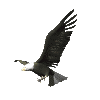
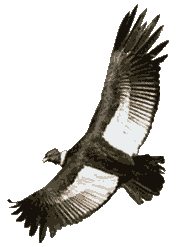


PERU ITINERARY
continued
![]()
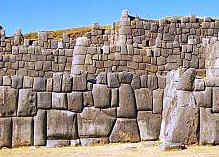

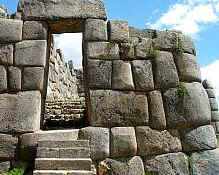
LACCO CAVE---CUSCO---SACSAYHUAMAN
Day 6 --- OCT. 10 --- Friday (Full Moon)
Morning tour of Sacsayhuaman:
Sacsayhuaman is one of the most
imposing architectonic complexes
and considered one of the best monuments
that mankind has built.
Three parallel walls built in different
levels with stones of enormous sizes;
zigzagging walls, because of their appearance,
one opinion is they represent the
"teeth" of the puma's head,
as Cusco is built in the shape of a Puma.
The boulders used for the first or
lower levels are the biggest;
there is one that is 28 ft.
high and weights about 361 tons.
Those boulders classify the walls as
being of cyclopean or megalithic architecture.
The three walls represent the three levels
of the Andean Religious World:
beginning from the bottom,
Uju Pacha (underground lower world),
the Kay Pacha (earth's surface stage)
in the middle, and the
Hanaq Pacha (sky, upper world) on the top.
The levels are also identified with their
three sacred animals:
the Amaru or (snake),
the Puma (Cougar or Mountain Lion),
and the Kuntur (Andean condor).
Because of the zigzagging shape of
the walls, it may be also suggested that they
represent "Illapa",
(spirit of thunder, lightning and thunderbolt).
In the heart of Sacsayhaman you reach an
energy vortex, Muyuc Marka,
where the Inca performed special rituals
to create a connection with the cosmic world.
Muyuc Marka, Medicine Wheel of Sacsayhaman
is where one is "recharged" with
"positive energy"
and connected energetically and spiritually
to Earth Mothers ley lines.
It is also a solar clock and a
phonic space that produces different echoes.
Afternoon free to rest or shop and
explore this wonderful sacred city.
Dinner on your own,
then we will be led in ceremony by
Inkari Pachatusan (a mystical brotherhood
of Andean musicians shaman/priests
of Incan lineage) inside
Lacco Cave (The Temple of the Moon).
This observatory has,
serpents and birds carved into the rock
and were ceremonial centers of initiation,
healing and rebirthing.
(BB, BL) Overnight Don Carlos, Cusco
![]()
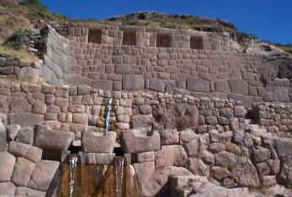
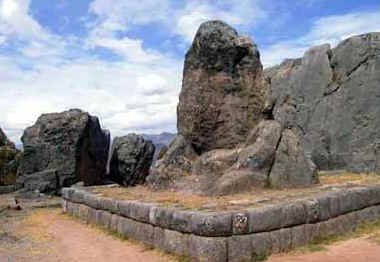

CUSCO - TAMBOMACHAY---KORICANCHA---QENKO
Day 7 --- OCT. 11 --- Saturday
Morning city tour of the Koricancha,
House of Light.
The Temple of the Sun
was the holiest of holy to the Incas
as it housed the great Sun Disk,
brought to Cusco,
“The Navel of the World”, from MU.
The rooms were adorned with
elaborate gold ceremonial objects
including the huge Sun Disk
reflecting the sun light to illuminate all.
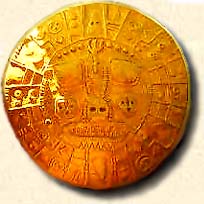
The walls were covered in gold,
and windows were constructed,
so the sun would cast a near-blinding
reflection of golden light
off the precious metals.
This site was a ceremonial center
featuring a number of stone
rectangular buildings laid out as to be
the convergence point of ley lines
connected to numerous
"huacas" or power spots.
The carved stone walls fit so perfectly
that a sheet of paper can not
slide between them.
There is no mortar.
These walls of the Temple of the Sun
are the finest example of Inca stonework
in existence.
The Cathedral
The church is located in the northeast
side of the Plaza des Armas,
built in 1550 and built with
many of the stones from the Temple of the Sun.
It contains over four hundred
XII century paintings done by the
members of the renowned Cuzco School.
The Lord of the Earthquakes altar
weights over 52 pounds and is made
of solid gold and studded with precious stones.
The main altar is covered with sheets of silver.
We then ride 7 miles into the country side
above Cusco to Tambomachay and Qenko.
Tambomachay, Unu, (Water Spirit)
Temple was popularly known as the
"Inca's Baths",
where four underground rivers come together.
It was here that those wishing to enter the
capitol of the Incan empire cleansed themselves.
It is an archaeological complex
made up of well-crafted canals, walls
and windows which show the Incas'
extraordinary architectural talents and
their in-depth knowledge of hydraulics.
Tambomachay was an important religious center
for the Spirit of water.
The canals channel the water,
ending at a slope from which crystal
clear water flows in three levels,
representing the 3 worlds.
We will honor the Spirit of water with
an offering and ask the sacred waters for
purification and clarity.
Qenko, Labyrinth, has many aspects;
astronomical and ceremonial.
It possesses an amphitheater with 19 niches,
and there is an entrance in the form
of a labyrinth which leads to the
underground temples.
There are statues in the upper part
where rituals took place,
although many of the carved sacred stones
were distorted by the Spanish,
the magic and energies were untouched.
We will align with the sacred ley lines
of the sites by honoring the ancient ones
who came before us as we walk through this
powerful healing, initiation, and astronomical complex.
Late afternoon return to our hotel,
and evening free.
(BB & BL) Overnight Don Carlos, Cusco
![]()

~continue~